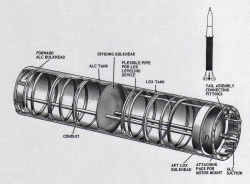Rocket Main Tank: Difference between revisions
→Cryogenic fuel tanks: about evaporation |
m →Wall thickness and material: material compat. |
||
| Line 21: | Line 21: | ||
==Wall thickness and material== | ==Wall thickness and material== | ||
Tank material mostly | Tank material first has to be stable with what's inside. Lists are available for cryogenic liquids at least. Besides this basic filter, the material choice mostly depends on money and on what's available on the market. For pressurized tanks, we will use 6061 aluminium or steel. | ||
The thickness of the tank walls obviously depend on the internal pressure, but also on the diameter of the tank. See [http://www.innovatia.com/Design_Center/FundRoc_4-8.htm]. Aluminium walls can be 2mm thick and 0.4m wide for a pressure up to 13 bar with no safety factor. | The thickness of the tank walls obviously depend on the internal pressure, but also on the diameter of the tank. See [http://www.innovatia.com/Design_Center/FundRoc_4-8.htm]. Aluminium walls can be 2mm thick and 0.4m wide for a pressure up to 13 bar with no safety factor. | ||
Revision as of 04:13, 8 November 2012
Rocket Fuel tanks
In modern launchers, two tanks are used, one for fuel and one for the oxidizer, but it has not always been the case. The Redstone rocket for example used a single tank with an internal separation, as we can see below.

Sloshing and other effects
Special care must be taken to avoid sloshing and vortexes in the tanks, that may lead to bubbles in propellant flow.
Cryogenic fuel tanks
See LOX page too.
Cryogenic and also low boiling temperature liquids like nitrous oxide are persistently evaporating at ambient temperature. It's like having water at 100°C and providing always more heat to it.
When the vapour pressure is high enough, and when tanks are solid enough too, the evaporation can reach equilibrium and the tank can contain a stable mix of liquid and gas at high pressure. This is the case for nitrous oxide at temperatures below 36.4°C, its critical temperature above which it turns all into gas, no matter what pressure is used. The issue then becomes the density of the mixture, which drops greatly.
For LOX, the critical temperature is -118.59°C, and the critical pressure is 50.43 bar. There's no point in keeping it so much pressurized because it could just boil off at this temperature. Since the phase change occurs at a constant temperature, we can as well choose a temperature and a pressure at which the LOX density is high enough, but that's a trade-off with the evaporation rate. Since the temperature difference between inside and outside the tank is greater, even more heat is transferred to the LOX, and more evaporation is created. Tank insulation is then required to avoid venting all the propellant before actually using it (balloon or aircraft launch can take some time to get to the launch altitude).
Wall thickness and material
Tank material first has to be stable with what's inside. Lists are available for cryogenic liquids at least. Besides this basic filter, the material choice mostly depends on money and on what's available on the market. For pressurized tanks, we will use 6061 aluminium or steel.
The thickness of the tank walls obviously depend on the internal pressure, but also on the diameter of the tank. See [1]. Aluminium walls can be 2mm thick and 0.4m wide for a pressure up to 13 bar with no safety factor.
Accessories
Engine fuel supply pipe and valve, tank pressure sensor, fill and drain pipes and valves.
For a cryogenic fuel or a high vapour pressure fuel tank: pressure relief valve, venting valve.
Thermal insulation
Cryogenic fuel tanks benefit from being insulated, which limits vaporization or even prevents boiling.
A list of thermal conductivities (k) is available on Wikipedia.
| Material | k (mW/m.K) | density (kg/m3) | availability,comments |
|---|---|---|---|
| PU foam | 22 | a density of 24 to 32 (1.5 to 2 LB/cu.ft) should be enough | readily available, cheap, sprayedq |
| Expanded polystyrene | 32 to 38 | 40 to 15 (resp.) | readily available in boards, cheap |
| cotton | around 30 | readily available, cheap | |
| mineral insulation | around 40 | ||
| neoprene | 54 | 960 | readily available, cheap, heavy |
A more precise list of low conductivity materials is available here.